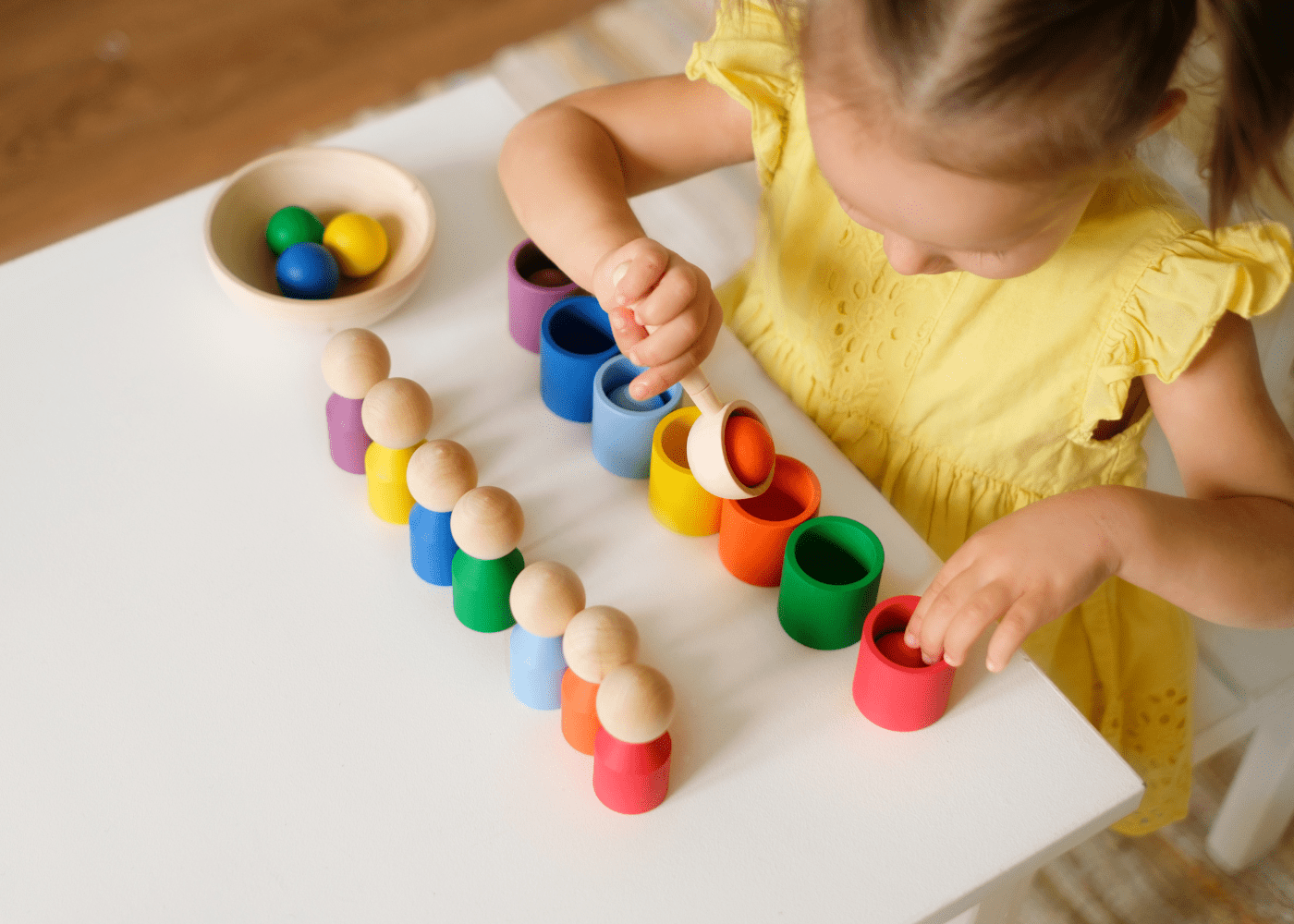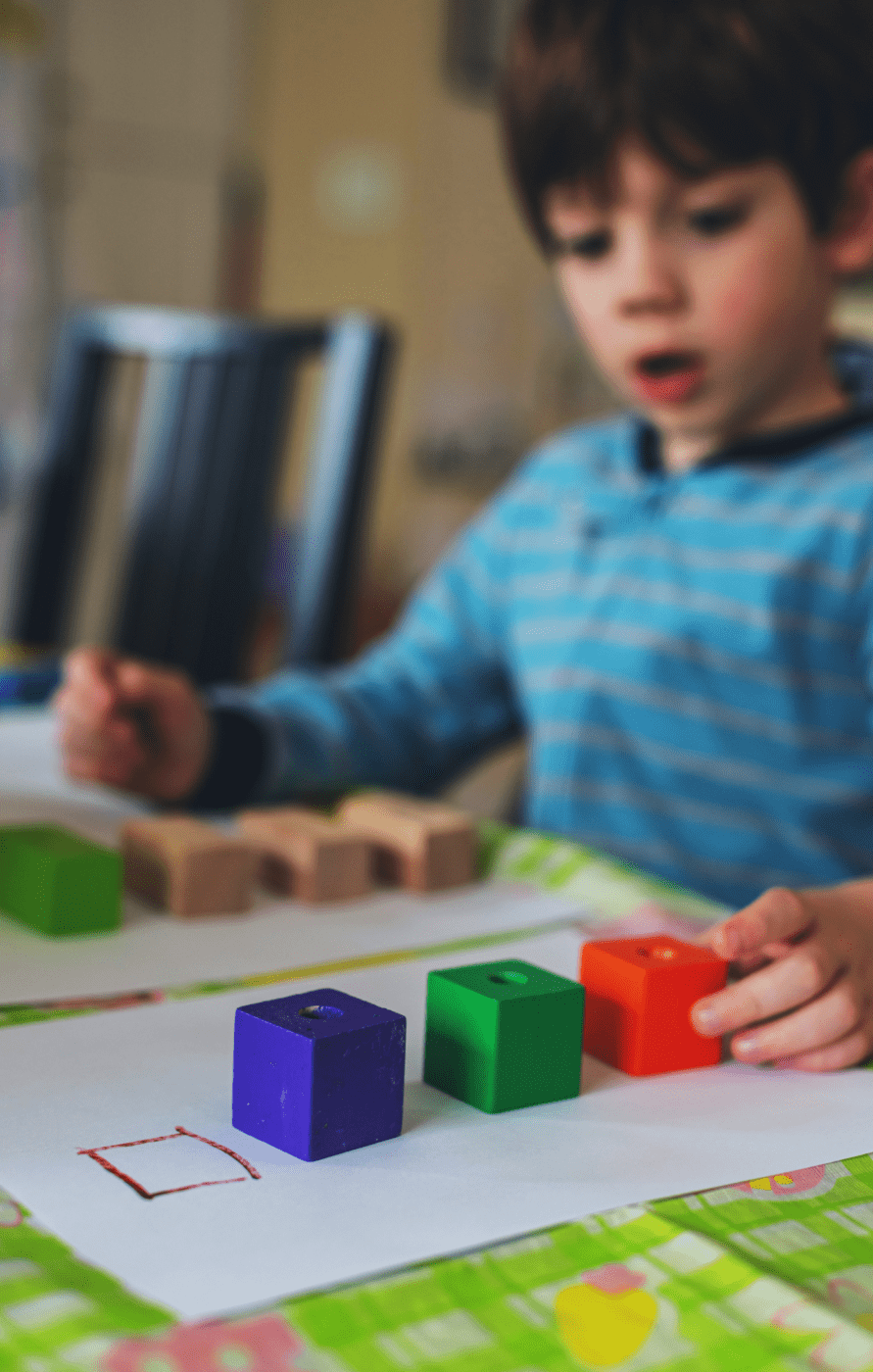Sorting activities are a great way to teach your preschooler some essential early literacy and math skills. This skill focuses on categorizing, organizing, and noting similarities and differences in order by grouping objects that are similar. Sorting also helps children develop critical executive function skills. Plus, they will be learning about sizes, shapes, and colors, all of which are important preschool math concepts!
For ideas about how to practice this essential skill at home, keep reading.
Here’s what we will cover in this article:

What are sorting activities for preschoolers?
Sorting activities are simply activities that require your little one to organize items based on similar characteristics or traits. There are many ways you can sort, but at this age, it’s all about keeping it simple. You’ll want to stick to sorting by only one characteristic at a time.
Why should children learn how to sort?
Preschool sorting activities are a great way to teach your child basic math concepts. Sorting is a key skill for preschoolers to learn as it helps them to understand and remember information. When children sort, they are classifying objects according to their attributes. This process helps children to make order out of the world and enables them to see relationships between things. Sorting is also a precursor to other math concepts such as counting, classifying, and comparing.
Early childhood mathematics includes counting and the application of counting; reading and representing simple numbers; mathematical activities concerning shape and mathematical activities concerning sorting, matching and comparing.
Lundqvist et al., 2021
According to Cindy Hovington, Ph.D. and Founder of Curious Neuron, sorting activities also help develop executive function skills (memory, attention, and problem-solving). It is stated that if children practice sorting activities in their preschool years, they are more likely to have better school performance and better math skills, specifically.
Sorting rules
“Sorting rules” are the rule that we use to sort similar items. For example, when you ask a child to sort a bunch of pom poms sort by color, the rule would be “sort all of the pom poms into the container of the matching color.”
I’ll elaborate on each type of sorting later in this post, but one of the easiest ways to sort is by color. You can start with a simple activity like sorting colored balls into different buckets. You can also sort different objects by color, like blocks, crayons, or even clothes.
Another way to sort is by size. This is a great way to help your child understand measurements. You can start with sorting balls or blocks by size, and then move on to sorting everyday objects like stuffies or books.
You can also sort by shape. This is a great way to help your child learn about geometry. Start with simple shapes like sorting circles, squares, and triangles. Then move on to more complex shapes like sorting stars, hearts, or animals.
Finally, you can sort by function. Another way to think of this. is sorting objects by what they do.
Also, engage them in the process by asking them how they would like to sort items! After all, they will have much more fun ‘doing it their own way‘ rather than just following the sorting rules you’re giving them.

Tips for sorting with preschoolers
Here are some top tips to help when you’re teaching sorting at this age:
- Keep it simple! Only sort by one characteristic at a time
- Use labels. Consider making labels (or printing ones from online) to help them organize. While this may not make sense for simple activities, it can help with things they need to organize routinely, like toys or clothes
- Let them choose! Little ones love choice. Try asking them “how should we sort these?” or asking “should we sort them by color or size?” This gets them more engaged in learning.
- Use concrete objects. When doing sorting activities for preschool learners, use things that they can hold and feel. This hands-on experience makes a big difference for most children.
- Math talk as much as you can. Try using as much age-appropriate math talk as you can. Ask questions like “is this object bigger or smaller than the other?” to help develop math language and literacy skills
- Make it relevant and practice it routinely. Sorting doesn’t just have to be with craft materials and toys. Toddlers can also learn sorting by helping out with sorting their clothes by figuring out where they should be put or sorting the dishes, for example
Sorting activities you can do at home
There are many preschool sorting activities that you can use to teach your child basic math concepts. As we mentioned, sorting is a great way to help your child understand patterns and relationships. But, it can also help develop fine motor skills and hand-eye coordination!
Types of preschool sorting activities you can do at home:
According to MSU, toddlers can learn to sort by color, size, shape and function. Here are some simple ways to practice these types of sorting at home.
1. Color sorting
You can sort objects by their color. For example, you can sort a pile of balls by their color. Red balls go in one pile, blue balls go in another pile, etc. Make this more fun (while practicing gross motor skills) by asking them to throw or kick the balls into the correct spot based on color. If you do this, try setting up a hula hoop or a bin with the corresponding color labeled on it.
Color sorting games are a great way to introduce sorting, too, since according to Judith Hudson at Baby Center, kids have the ability to identify colors from the time they are about 18 months. At this time, they are also learning to identify size and shape. By the preschool age, though, they will be starting to learn color names.
Sorting colors is also quite easy since colored materials are everywhere! Young children can sort buttons, pipe cleaners, pom poms, or sorting beads by color, for example.
2. Size sorting
You can also sort objects by their size. For example, you can sort a pile of blocks by their size. The biggest blocks go in one pile, the middle-sized blocks go in another pile, and the smallest blocks go in another pile.
Be sure to make it clear which size is small, medium, or large by giving an example of an object that goes in each category. This gives the little one something to compare to. To do this you could either label three jars (“small,” “medium,” and “large”) and get them to drop items into the correct container, or you could have a page for each size if it’s something they can glue or stick down (like stickers).
3. Shape sorting
Another way to sort objects is by their shape. For example, if you have wooden geometric shapes, you can ask your little ones to sort the different shapes into piles. You might have round objects in one, triangle objects in another, and square objects in the last one.
Another idea is to make large shapes (either cut a piece of paper, draw the shape on the paper, or mark the shape on the floor with tape) and challenge your kiddo to find as many objects that match that shape from around the house. Classifying activities like this are great because they don’t require much prep!
5. Function sorting
Finally, you can sort objects by their function, or by what the objects are used for. When trying to teach children this sortinf rule, keep it super simple at first. Think of sorting by categories that they will easily understand, like “things we drink,” “things we eat,” or “things we wear.”
There are lots of pre-made cards and resources (like this free circle pictures by function worksheet) to help students sort items into categories. Or, if you have enough manipulatives, you could put pictures of the categories on containers and ask children to sort items.
Conclusion
We hope that you found some fun sorting activities and ideas for your prek learners to practice their math skills! By sorting objects into groups, your child can learn about quantity, order, measuring, and comparisons. These skills are essential for understanding more complex math concepts later on. So have fun sorting with your preschooler – it’s math time!
Frequently Asked Questions
Here are answers to some of the most frequently asked questions about preschool sorting activities.
How do you teach preschoolers how to sort?
Sorting activities for this age group should be kept super simple – One characteristic at a time! This means you could prompt your littles to sort by color, shape, or size… But not all three. Using cards with pictures or labels helps make sorting more concrete, too.
What are sorting activities for preschoolers?
Essentially, sorting is all about looking for common attributes and categorizing items accordingly. This is a little different from matching (which asks them to put together two like items), and instead asks them to create groups.
Why are sorting activities important for preschoolers?
Sorting is a fundamental math concept that they will need to learn once they are in Kindergarten. It’s also a fundamental literacyTally mark worksheets (with free printable!) skill, too! In essence, sorting activities are a way to teach your child to notice similarities and differences and how to categorize items.
Resources
We’ve got lots of other math posts for young learners. Here are a few that you may enjoy!
- Kindergarten math word problems
- Number tracing worksheets (1-10)
- Math concepts your children will learn in kindergarten
- Money matters: Free preschool money worksheets
- Tally mark worksheets (Free printable)
- Ways to teach preschool math outdoors
References
This post references scholarly literature. Here’s who we gathered our information from:
Cindy Hovington, Ph.D. and Founder of Curious Neuron
Johanna Lundqvist, Karin Franzén & Ann-Charlotte Munter (2021) Early childhood mathematics: a case study, Early Years, DOI: 10.1080/09575146.2021.2014404
Math for young learners
Math is one of many subjects your child will learn in school. Read about some of our favorite ways to teach and learn about math with preschool and kindergarten learners!
